Information about your Web browser
JavaScript is supported by the Camino, Firefox, iCab, Internet Explorer, Konqueror, Netscape, OmniWeb, Opera, Safari and SeaMonkey Web browsers, and so almost everyone can use it. However, some people worry that it can be abused by disreputable Web site owners, and choose to disable it.
JavaScript is used on several pages on this Web site, but it is only essential on the pages that demonstrate the information that can be determined about your Web browser and computer by using JavaScript.
|
|
Internet Explorer 7
- Open the "Tools" menu.
- Select "Internet Options", to open the Internet Options dialog box.
- Click the "Security" tab.
- Click the "Internet" symbol (a globe).
- Click the "Custom Level…" button, to open the Security Settings dialog box.
- In the Settings list, scroll down to "Scripting".
- Under Active Scripting, click the radio button to the left of "Enable", so that a coloured dot appears in it. (Click "Disable" if you want to disable JavaScript.)
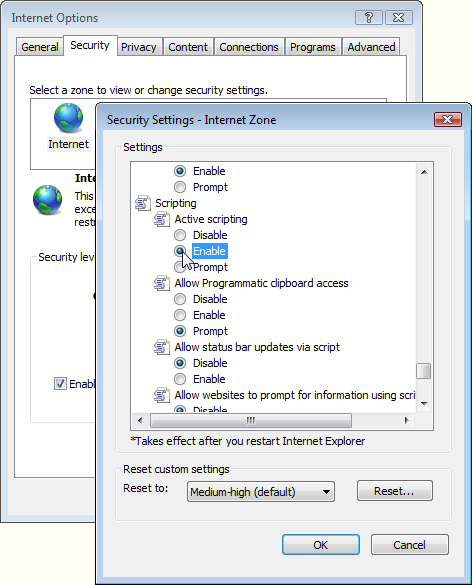
- (If you are unsure about the other Security Settings, please check with your Network Administrator.)
- Click "OK" to close the Security Settings dialog box.
- Click "Yes" in the Warning! message box.
- Click "OK" to close the Internet Options dialog box.
Internet Explorer 6
- Open the "Tools" menu.
- Select "Internet Options…", to open the Internet Options dialog box.
- Click the "Security" tab.
- Click the "Internet" symbol (a globe).
- Click the "Custom Level…" button, to open the Security Settings dialog box.
- In the Settings list, scroll down to "Scripting".
- Under Active Scripting, click "Enable", so that a dot appears next to it. (Click "Disable" if you want to disable JavaScript.)
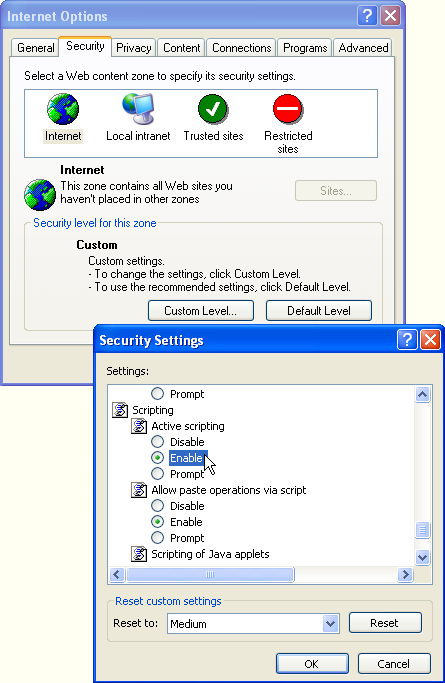
- (If you are unsure about the other Security Settings, please check with your Network Administrator.)
- Click "OK" to close the Security Settings dialog box.
- Click "Yes" in the Warning! message box.
- Click "OK" to close the Internet Options dialog box.
Firefox
- Open the "Tools" menu.
- Select "Options…", to open the Options dialog box.
- In the row of coloured icons at the top, click "Content".
- Click the check box to the left of "Enable JavaScript" so that a tick appears. (Click again to remove the tick if you want to disable JavaScript.)
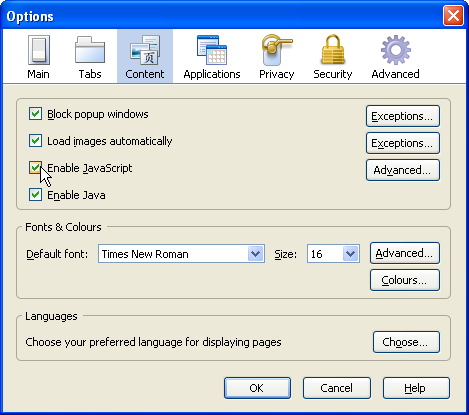
- Click "OK" to close the Options dialog box.
If you are using Mac OS X, then you need to select Preferences… on the Firefox menu, instead of Options… on the Tools menu.
Opera
- Open the "File" menu (version 6) or the "Tools" menu (versions 7, 8 and 9).
- Point to "Quick preferences".
- In the submenu that appears, click "Enable JavaScript" to add or remove the tick.
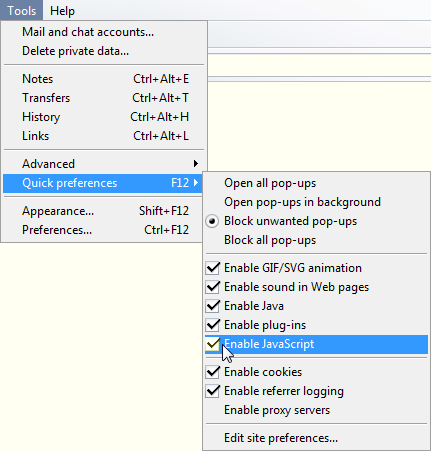
If you are using Mac OS X, then you need to select "Quick preferences" on the Opera menu, instead of the Tools menu.
Safari
- Open the Safari menu (OS X), or the "Edit" menu (Windows).
- Select "Preferences…"
- In the Preferences dialog box, click the Security icon (a padlock).
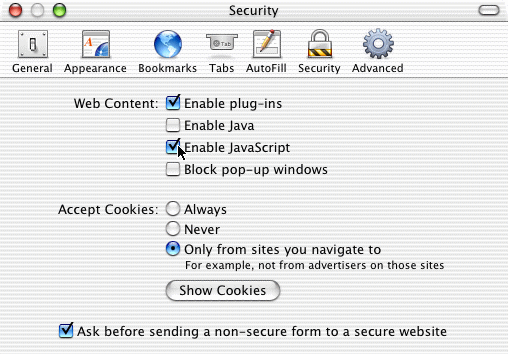
- In the Web Content section, click the check box next to "Enable JavaScript" so that a tick appears. (Click again to remove the tick if you want to disable JavaScript.)
- Close the Preferences dialog box by clicking the red button at the top left (OS X) or by clicking the X icon at the top right (Windows).
Camino
- Open the "Camino" menu.
- Click "Preferences…" to open a dialog box.
- Click "Web Features".
- In the Content Control section, click "Enable JavaScript… so that a tick appears.
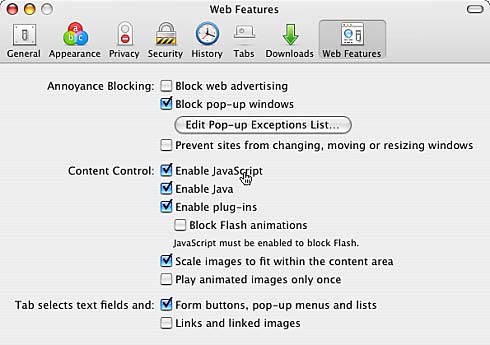
- Close the Preferences dialog box by clicking the red button at the top left.
SeaMonkey
- Open the "Edit" menu (Windows), or the SeaMonkey menu (OS X).
- Select "Preferences…", to open the Preferences dialog box.
- In the Category list, click the "+" sign next to "Advanced" so that a list of items appears.
- In the list of items beneath Advanced, click "Scripts & Plug-ins".
- To the right of the list, beneath Enable JavaScript for, click "Navigator" so that a tick appears. (Click again to remove the tick if you want to disable JavaScript.)
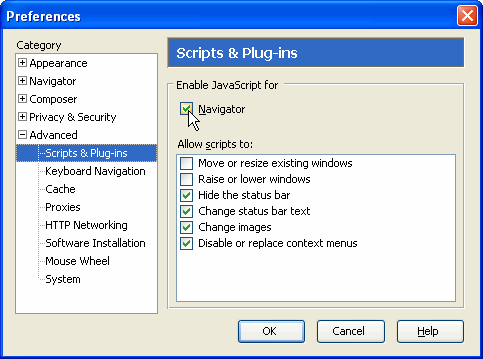
- Click "OK" to close the Preferences dialog box.
Internet Explorer 4.x or 5.x (Windows)
- Open the Tools menu.
- Click Internet Options…
- Click the Security tab.
- Click the Internet symbol (a globe).
- Click the Custom Level… button.
- In the Settings list, scroll down to Scripting.
- Under Active Scripting, select either Enable or Disable.
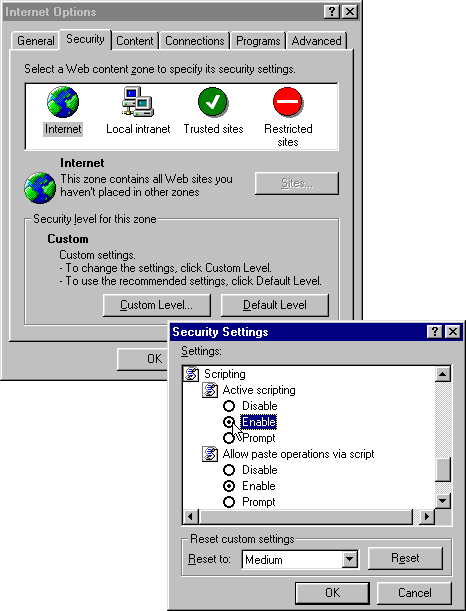
- Click OK.
- Click Yes in the Warning! message box.
- Click OK.
Internet Explorer 4.x or 5.x (Mac)
- Open the Edit menu (OS 9) or the Explorer menu (OS X).
- Click Preferences…
- In the scrolling list on the left, click Web Browser so that you can see the bulleted items beneath it.
- Click Web Content.
- In the Active Content section, click the check box next to "Enable scripting" so that a tick appears. (Click again to remove the tick if you want to disable JavaScript.)
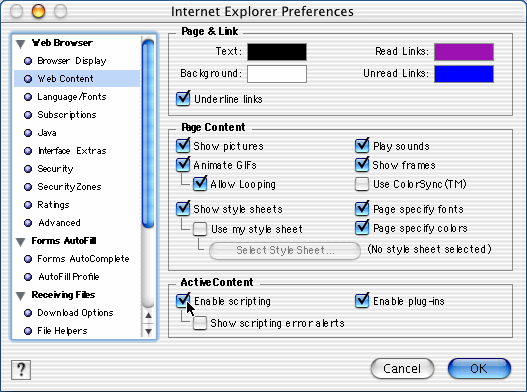
- Click OK.
Netscape 4.x or 6.x (Windows or Mac)
- Open the Edit menu.
- Click Preferences…
- In the Category list, select Advanced.
- To the right of the list, select "Enable JavaScript" to add or remove the tick.
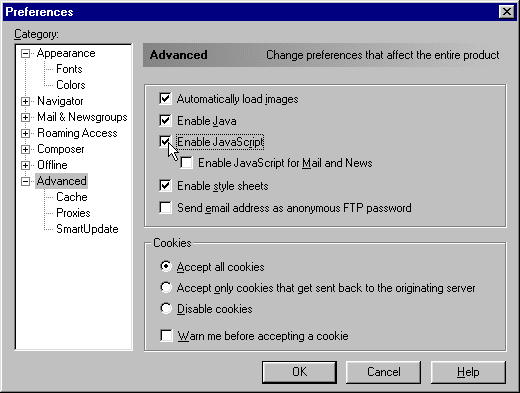
- Click OK.
Netscape 3.x (Windows)
- Open the Options menu.
- Click Network Preferences…
- In the Preferences dialog box, click the Languages tab.
- Click the check box to produce a tick next to "Enable JavaScript". Click again to remove the tick and disable support.
- Click OK.
Netscape 2.x (Windows)
- Open the Options menu.
- Click Security Preferences…
- In the Preferences dialog box, click the General tab.
- Click the check box to remove a tick next to "Disable JavaScript". Click again to add a tick and disable support.
- Click OK.
No comments:
Post a Comment